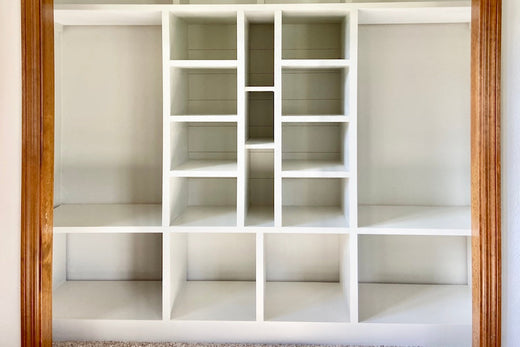Prispôsobte si tieto kocky tak, aby sa zmestili do akéhokoľvek priestoru, ktorý chcete zorganizovať!

obtiažnosť: Easy
Materiály:
Výrobky z dreva
- Preglejka (1 list) – 3/4” x 4” x 8” → 19 mm x 1220 mm x 2440 mm
Hardvér a spotrebný materiál
- 1 škatuľa 1 ¼” skrutiek s vreckom
- 1 balenie policových kolíkov Kreg
- 1 lepidlo na drevo
- 1 pár bezpečnostných okuliarov / OOP
- 1 Farba alebo škvrna podľa výberu
- 2 Svorky
- 1 Meracia páska
- 1 Úroveň
Zoznam prírezov a dielov:
- Bočné diely (4) – 48” x 12” → 1219 mm x 305 mm
- Poličky (8) – 10,5” x 12” → 267 mm x 305 mm
- Hore (1) – 74” x 12” → 1880 mm x 305 mm
Pokyny:
-
Krok 1 – Pozrite si video YouTube
Pozrite sa na to, aby ste videli postup krokov popísaných tu, PLUS pozrite sa, ako používam tento základný plán na stavbu kabín a vytváram si vlastný systém organizácie šatníka so základnou štruktúrou a rámami tváre.
Tip:
-Pracovníci v obchode vám s radosťou rozrežú preglejku na mieru. Je to skvelý spôsob, ako naštartovať svoj projekt tým, že im necháte rozrezať niektoré z vašich kúskov na požadovanú veľkosť! Len sa uistite, že ich požiadate, aby išli na panelovú pílu pomaly, aby sa vyhli drsnej hrane dreva.
-Uistite sa, že golier na vrtáku na vŕtanie otvorov do vreciek je nastavený na 3/4” tak, aby zodpovedal hrúbke vašich panelov
-Pred spustením projektu si prečítajte úplné pokyny, aby ste mohli predvídať, čo je potrebné a kedy. Šťastná budova!2 - Vystrihnúť
všetky vaše komponenty na mieru. — Použil som pásovú pílu, ale môžete použiť kotúčovú pílu s priamou hranou, vodiacu okružnú pílu Kreg Rip Cut alebo ponornú pílu Kreg ACS, alebo môžete využiť bezplatné rezy v obchode!
3 - Vŕtačka
otvory pre vrecká pomocou Kreg 720PRO do 6 z 8 políc na ľavej aj pravej strane. Urobíme 2 z políc nastaviteľné tak, aby nepotrebovali otvory na vrecká. Urobte každý otvor do vrecka asi 2” od okrajov a pridajte 1 do stredu pre extra poistenie.
4 - Vŕtačka
otvory pomocou Kreg Shelf Pin Jig na 2 zo 4 bočných panelov. Tieto budú oproti sebe v prípade centrálnych políc. V závislosti od toho, akú nastaviteľnosť chcete, môžete preskočiť každú druhú dieru.
5 - Zostavte
cubbies tým, že najprv označíte, kam chcete umiestniť police. Rád umiestňujem všetko tam, kde to podľa mňa vyzerá dobre, alebo používam krajčírsky meter na rovnomerné rozmiestnenie políc. Použite štvorec a úroveň, aby ste sa uistili, že police nebudú nerovnomerné. Ceruzkou si označte, kde ich plánujete upevniť po stranách. Tu môžete použiť lepidlo na drevo, ak ho máte, ale nie je to 100% potrebné. Nakoniec pripevnite policu na požadované miesto medzi bočné diely a pripevnite ich pomocou skrutiek Kreg.
6 - Opakujte
tento proces pre každú policu.Upevnil som svoj vrchný diel dole do krabíc pomocou skrutiek, ale ak je to pre váš priestor jednoduchšie, môžete sa rozhodnúť pre stolárstvo s vreckami. Zvážte použitie nástenných príchytiek na podopretie koncov horného dielu, aby ste sa časom vyhli prehýbaniu.
7 - Dokončiť
(voliteľné) váš projekt s rámovaním tváre na skrytie okrajov preglejky. Môžete to urobiť s použitím materiálu 1x2 a jeho narezaním na rovnakú dĺžku, akú ste si vybrali pre bočné diely a police. Vycentrujte ho rovnomerne na preglejkové časti. Tieto ozdobné kúsky môžete jednoducho prilepiť a priklincovať na prednú časť vašich mačiatok. Namaľujte alebo nafarbite svoj projekt a potom nainštalujte! Nezabudnite sa odfotiť pred svojou zostavou a označiť @oakhillmillworks a @kregjig na Instagrame, aby sme to videli!
Tip:
*Ako som spomenul v kroku 1, pokračoval som v budovaní ďalšej kóje, ktorá bola vodorovne pre môj šatník, a na vrch som dal tieto menšie zvislé kóje. Je to presne ten istý proces, ak by ste chceli pokračovať v budovaní ďalších kójí a zistiť, ako ich môžete spojiť pre svoj vlastný projekt organizácie! Viac nápadov nájdete vo videu!









Podieľať sa:
Organizátor DIY skrinky so zásuvkami
DIY Underbed Storage